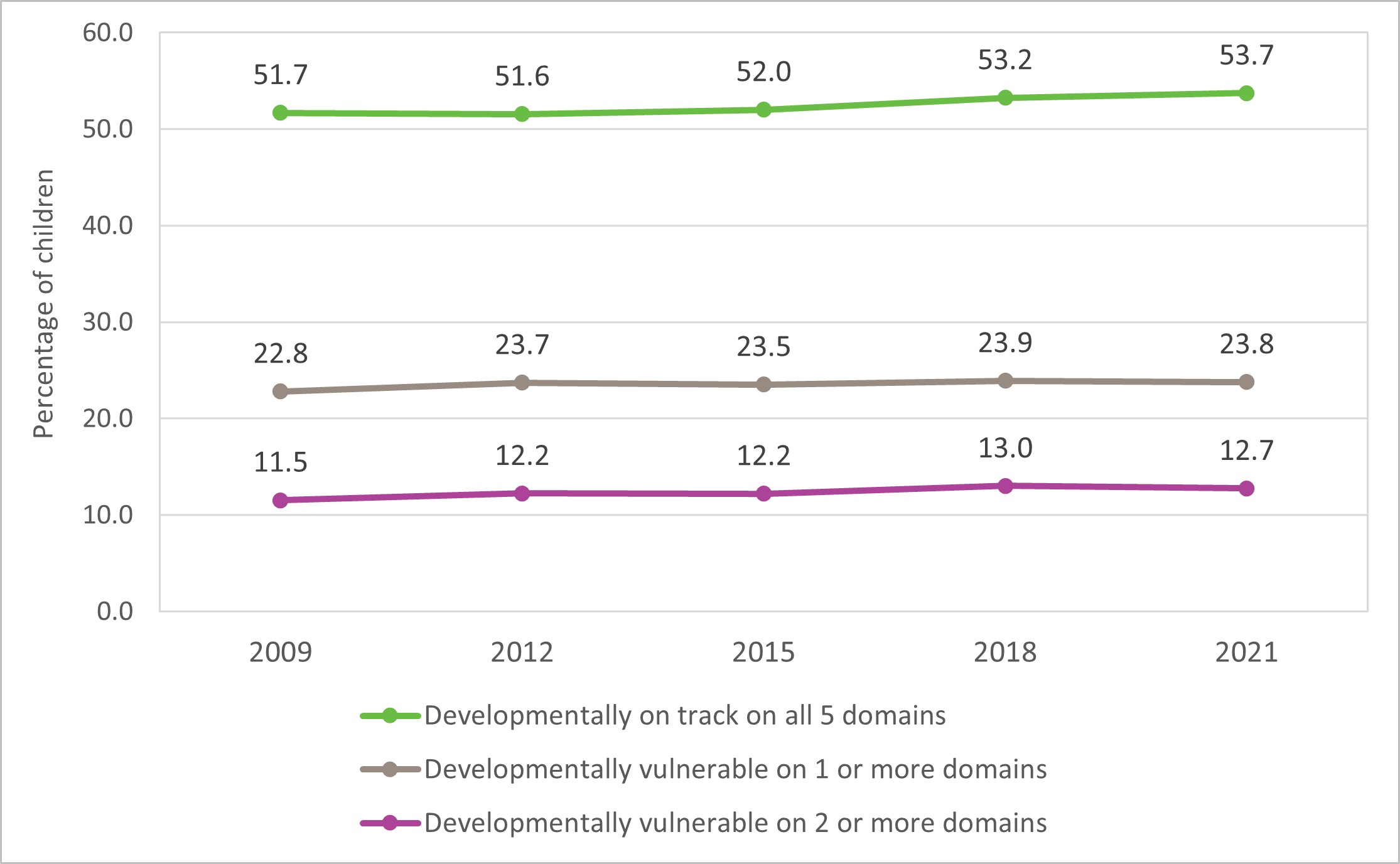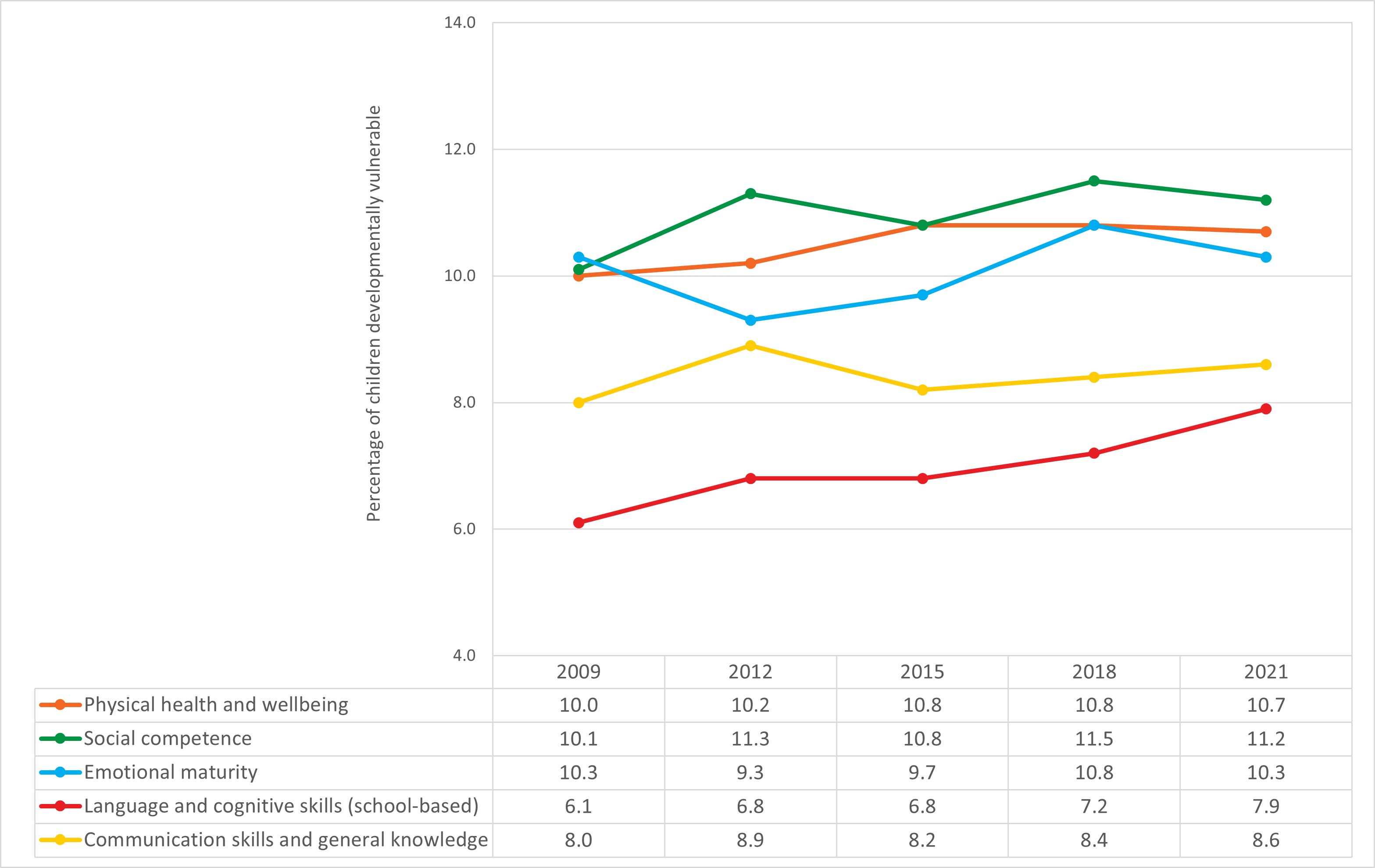On this page
The Australian Government works with its partners and state and territory governments to implement the Australian Early Development Census (AEDC). The census takes place every 3 years and has been in effect since 2009. The AEDC collects information about the development of children in Australia at the time they start their first year of full-time school.
National, state and community census data is available on the AEDC Data Explorer.
Policy makers, service providers, governments, communities, education sectors and researchers use AEDC data to inform policy, planning, services and collaborations for children and families.
South Australia will use the AEDC data to measure progress against its target to reduce the proportion of children developmentally vulnerable as assessed by the AEDC from 23.8% in 2021 to 15% by 2043, as per the Royal Commission into Early Childhood Education and Care recommendation.
2024 AEDC data release
The 2024 AEDC data collection took place from 1 May 2024 to 5 July 2024.
Participating schools accessed their AEDC Schools Profiles once finalised in the collection. Schools can email Helpdesk@aedc.gov.au to get a copy of their reports if required.
In March 2025, AEDC results at national, state and community level will be released on the National AEDC website .
The 5 domains of early childhood development
AEDC data highlights how children have developed across 5 important areas of early childhood development called domains. These domains support them to engage in learning and connect with peers at school.
AEDC in context
Nearly a quarter (23.8%) of South Australian reception students had 1 or more developmental vulnerabilities in 2021, a 0.1% decrease since 2018.
The 2021 data also shows a 0.5% improvement to 53.7% in the number of children who were on track across the 5 areas of development.
South Australia’s improvement in the 2021 census compares favourably to a national trend of increased vulnerability; however, our rates of developmental vulnerability continue to be higher than most other jurisdictions.
With no significant shift in South Australia’s AEDC results over the last 13 years, the Office for the Early Years has been established to drive reductions in childhood development vulnerabilities. The office was established as a single point of leadership for early years services across government and to report on outcomes in the early years. The office will partner with key agencies including the Women’s and Children’s Health Network, the Department of Human Services and Wellbeing SA, as well as with local government, non-government organisations, universities and communities.
To encourage supportive and nurturing early years environments, essential for children’s social competence, emotional maturity, language and cognitive skills, physical health and overall wellbeing, new resources presenting Australian Early Development Census (AEDC) results for South Australia are available in 4 snapshots and a map, providing data and key findings in more detail.
These summary indicator results reflect the shifts in domain results as seen in the following graphs.
AEDC Summary indicators for South Australia
The following summary indicator graphs reflect shifts in domain results for South Australia over time.

Percentage of South Australian children developmentally vulnerable by AEDC domain from 2009 to 2021

The AEDC data can help governments, communities and schools improve our understanding of how to best support children and families.
In 2019 the South Australian Child Development Council established the South Australian Outcomes Framework for Children and Young People. The framework aims to help our youngest citizens to start well, grow strong and experience a good life. One measure of our progress in the framework is the proportion of children developmentally vulnerable on 1 or more domains under the AEDC when they enter school.
A range of factors impact children’s life outcomes. The AEDC can help us understand the environments children are growing up in, what might be supporting or getting in the way of their development and wellbeing, how families are supported in the early years and where to focus our efforts to make a difference.
Research has shown that investing time, effort and resources in the early years of a child’s life has a significant impact on their behaviour, learning, health and wellbeing as they transition from childhood to adulthood.
Children with a positive early childhood experience are more likely to achieve higher educational attainment, demonstrate high self-esteem and social development, and have fewer social and health problems.
Watch the video about Mid Murray family connections story below to learn how a local council implemented responses to their AEDC results.
Watch the Mid Murray family connections video
Video transcript – Mid Murray family connections
Amie Johnson: We cover 17 towns, the entire Mid Murray region. The AEDC data showed quiet a shocking picture I think for a lot of people. One in three children were classified as developmentally vulnerable on two or more domains.
Kylie Eggers: 10 or so years ago they did a mapping exercise of our data and realised that there are a lot of gaps and services in our town. We're just outside Murray Bridge, we're just outside the Barossa, we're just outside the Riverland, and so there was a very distinct gap.
John Robertson: This was a real catalyst and wake up call.
Amie Johnson: The initial idea was that Council would invest some staff time to start pulling things together, connecting the threads, you know, building those networks, strategic leaders. It was a really good starting point for council to have a look at what can we do? Who can we pull together? And start building a bit more holistic approach to children and families in our region. We have a network of about 60 partners. We had to choose a starting point. Where would the biggest impact be? So, emotional maturity was chosen by the network because we thought it would filter into those other domains, and because we know that well-being wraps around everything. I remember John Robertson, the Principal of Swan Reach, saying to me, “If they arrive at school when they haven't had breakfast, they haven't slept, unless we address those things, how do we teach them English and Maths?”
Kristy Castle: When I was first introduced to Mid Murray Family Connections. It was a call for mothers, parents or carers to start a Facebook group “Mid Murray Mums”, which it became known as. There were so many kids that weren't quite where they should be to be ready for school. It was crucial to sort of get in there early.
Amie Johnson: There was a big push around the importance of preschool. Parent Child Mother Goose was introduced, which is as you know a preschool learning program.
John Robertson: Swan Reach Area School is a Preschool to Year 12. Sixty three students. Reasonably isolated. It was necessary to put well-being front and center. Part of the agreement there was that the schools would take on the primary "Kids Matter” preschool, and “Mind Matters” secondary.
Kylie Eggers: The Mannum Way for us, it's a Reception to 12 process of how we can engage. Do as you would to others. Do your best, no matter who you're working with. It takes great strength to be sensible. Those sort of things.
Amie Johnson: So, there's quite a list. Supporting maternal health, connecting child and family health services to towns further out in the region, raising the awareness of the impacts of family violence.
Kylie Eggers: We really want to know where they're at when they first come to us, so that we can build on their strengths, build on what they need working on, and work with their families to ensure that they've got everything they need. The AEDC data is instrumental in making sure that we know where our students are at. For students who are not achieving, say, in their phonics assessment, have they had their hearing checked? We have a lot more conversations with the kindy about who's coming and what they can do, what they need support with, what the family is like and what supports they need.
John Robertson: So Mid Murray Family Connections have been a massive advocate to get these services out. You have CAMHS coming here on occasions. CAFHS now come here. So these services weren't, one seen as needed, perhaps two, known about.
Kristy Castle: The core of the time that I've been involved between the 2015 and the 2018 data, it continued to improve, and I was so impressed because I felt, I felt like what we were doing was actually making a difference.
Amie Johnson: We've worked out four focus areas. Children and caregivers share secure attachment. Children are emotionally resilient. Children are engaged learners, and children and caregivers are safe and supported. We use a community accountability plan that's put together with the whole network, which has got actions moving forward. We then review that plan and look at the new lot of data, look at the community stories.
Kylie Eggers: We know that there's been success because the data is improving over time, and so therefore the students are coming to school more school ready. Parents are coming to us to ask more about what psychological services, what parenting services, what financial support services?
Kristy Castle: If you get the right infographics and the right data to the right people, it just sets off a bit of a chain reaction.
Amie Johnson: What we found is it's been great having an invested position to help keep moving things forward. What it does do is it helps us advocate. It shows the need. This is what my community are telling me and this is what the data is showing. Moving forward we'll assess again. I'm looking forward to the next lot of data.
[End of transcript]
You can view interactive maps displaying 2018 AEDC results for South Australia on the Location SA map viewer. Metadata is also available for 2009, 2012, 2015 and 2018 collections providing information on children developmentally ‘on track’ on all 5 domains (OT5) and developmentally vulnerable on 1 or more domains. Additional data is being added to the platform over time (including the 2021 data) to help communities and governments explore their data on a familiar platform that can also overlay other relevant datasets like locations of services.
Learn how to use AEDC data
Access the AEDC professional learning program on PLINK, the Department for Education's professional learning platform.
This program will give you a deeper understanding of the AEDC. It demonstrates how to use the data to support children’s development in your programs, policies, planning and partnerships.
This program will help you:
- understand how to access and use AEDC data
- reflect on what is driving or obstructing children’s development and learning
- analyse AEDC data for change and improved outcomes for children
- identify strategic partners
- plan for programs, transitions and partnerships
- identify issues, opportunities and key actions to inform improvement planning and policy
- monitor and measure progress.
Real examples of practice explicitly connect AEDC data to quality (National Quality Standard and Australian Institute for Teaching and School Leadership) and curriculum planning (Early Years Learning Framework and Australian Curriculum) to support improved development and learning outcomes for children.
The program is approximately 1.5 hours long and made up of 4 modules.


